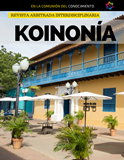Comparative analysis of gifted students from Ecuador and Peru
DOI:
https://doi.org/10.35381/r.k.v4i8.379Keywords:
Visual learning, Teaching and training, Self instruction, Independent study.Abstract
A comparative study was generated between gifted students from Ecuador and Peru, in order to know the learning styles prevalent between them. The research was descriptive, the population was made up of 8 students from educational institutions in Ecuador and 8 students from Peru who possess the characteristics of gifted people, the Ned Herrmann test was applied to know the predominant quadrant in their learning. Ecuadorian students have a greater predominance in the right limbic (LD) and left limbic (LI) hemispheres. While students from Peru, have a prevalence in the left cortex (CI) and the right cortical segment (CD). This implies that there is a diversity of learning in gifted students, which implies that pedagogical strategies that allow integrating gifted students with those who are not considered with this quality should be promoted.
Downloads
References
Aldana, J., Salón, M., & Guzmán, N. (2019). Liderazgo sistémico en las competencias gerenciales docentes universitarias. CIENCIAMATRIA, 5(8), 50-74. Recuperado a partir de http://cienciamatriarevista.org.ve/index.php/cm/article/view/87
Aldana Zavala, J., & Colina Ysea, F. (2019). Marketing verde en la conformación de una ciudadanía planetaria en el ámbito educativo latinoamericano. Revista San Gregorio, 0(31), 150-161. doi:http://dx.doi.org/10.36097/rsan.v0i31.972
Arias, F. (2009). El Proyecto de Investigación. Guía para su elaboración. Caracas: Epísteme. Quinta Edición.
Hernández, Fernández y Baptista (2014). Metodología de la investigación. México, Mc Graw Hill Hispanoamericana. Hill Internacional.
Lanni Gómez., L. (2017). MIRAMDA, una propuesta educativa emergente desde la investigación. Revista Arbitrada Interdisciplinaria Koinonía, 2(3), 9-30. Recuperado de http://fundacionkoinonia.com.ve/ojs/index.php/revistakoinonia/article/view/49/36
Martín, G. (2018). 11 características típicas del niño superdotado. Recuperado de https://www.guiadelnino.com/educacion/escuela-infantil-y-colegio/11-caracteristicas-tipicas-del-nino-superdotado
Salvador, I. (2018). Los 5 tipos de superdotación intelectual (y sus características). Recuperado de https://psicologiaymente.com/inteligencia/tipos-de-superdotacion
Tamayo y Tamayo (2009). El proceso de investigación científica. Limusa. México.
Published
How to Cite
Issue
Section
License
CC BY-NC-SA : Esta licencia permite a los reutilizadores distribuir, remezclar, adaptar y construir sobre el material en cualquier medio o formato solo con fines no comerciales, y solo siempre y cuando se dé la atribución al creador. Si remezcla, adapta o construye sobre el material, debe licenciar el material modificado bajo términos idénticos.
OAI-PMH URL: https://fundacionkoinonia.com.ve/ojs/index.php/revistakoinonia/oai.









